Kelly Jensen's Blog, page 116
April 15, 2014
Cover Double, Triple, and (formerly) Quadruple: Risk Taking and Cover Design
I haven't done a cover double post in quite a while, but here's one. Let me start at the beginning because this cover has had a journey to it.

Sourcebooks unveiled this as the cover for Juliana Stone's Boys Like You at the end of last year or beginning of this year. It's cute, but it's not necessarily remarkable. It looks like a light romance title. But that cover didn't last long, and instead, Sourcebooks took it in a new direction:

This cover tells an entirely different story. It might still be a romance, but it doesn't look as light as the previous cover. The redesign definitely fits into the trend of text and image driven covers that are becoming the new dominant look in YA (almost to the point those all look the same too).
The book's description (via WorldCat): When Monroe Blackwell, who is spending the summer at her grandmother's Louisiana bed-and-breakfast, meets Nathan Everets, who has a court-appointed job there, they share, and begin to recover from, their respective feelings of loss and guilt.
I don't think either cover quite nails it via description alone. The tag line, which changed a little bit between cover redesigns, does a pretty good job capturing it, but I'm not sure where the guitar fits in in the new look and for the old one, it might just look too lighthearted.
Stone's book comes out May 6.
Let's return to that first cover iteration, though. That stock image is going to get quite a bit of play elsewhere, even though it didn't end up being used for Boys Like You.

Kat Spears's debut novel Sway will get the stock image. The title and the author placement are exactly the same as they were in Stone's book, too. Again, there's the feeling of a lighthearted romance here, despite the fact the tagline conveys something different.
Because Sway doesn't come out until September 16, there's not yet a description up in WorldCat, but here's the lengthier one from Goodreads:
High school senior Jesse Alderman, or Sway as he's known, could sell hell to a bishop. He also specializes in getting things people want—term papers, a date with the prom queen, fake IDs. It's all business with Jesse. He has few close friends and he never lets emotions get in the way.
But when Ken, captain of the football team, leading candidate for homecoming king, and all around jerk, hires Jesse to help him win the heart of the angelic Bridget Smalley, Jesse finds himself feeling all sorts of things. While following Bridget and learning the intimate details of her life, he falls helplessly in love for the very first time. He also finds himself in an accidental friendship with Bridget's younger brother who's belligerent and self-pitying after spending a lifetime dealing with cerebral palsy. Suddenly Jesse is visiting old folks at a nursing home in order to run into Bridget, and offering his time to help the less fortunate, all the while developing a bond with this young man who idolizes him. The tinman really does have a heart after all.
A Cyrano De Bergerac story with a modern twist, Sway is told from Jesse’s point of view with unapologetic truth and biting humor. His observations about the world around him are untempered by empathy or compassion--until Bridget's presence in his life forces him to confront his quiet devastation over a life changing event a year earlier and maybe, just maybe, feel SOMEthing, again.
It's a male point of view, though from the cover, I'd never quite get that. I like that my expectations are bucked like that, but I wonder how much the cover image conveys what the story looks to be about. It's a fairly generic image that suggests light romance, and I'm not sure if that's what the book is about.
While I do not think that books have gender and wouldn't hesitate to hand a boy a book like this, I think it's the kind of cover that could be difficult for boys to pick up on their own from the shelf. Romance fans, though, would definitely gravitate toward this, regardless of gender.
When Spears's cover was revealed a couple of weeks ago, another cover was revealed from Entangled Teen that looked pretty familiar.
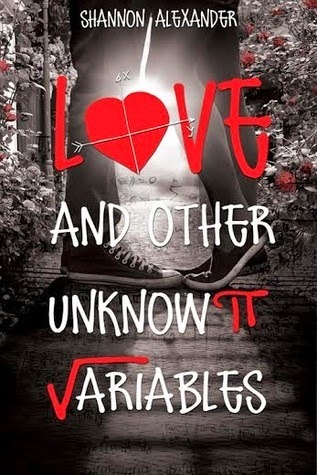
The same stock image is the base for Shannon Alexander's Love and Other Unknown Variables, which will come out October 7. While it isn't the same exact treatment, it's clearly the same stock picture. What's interesting about this cover is that the side elements are completely different, as they've been done up with flowers (to the point where it looks like the plants are rubbing against the girl's leg in a weird and uncomfortable way) and the color has been completely stripped, save for the pops of red. The placement of the title and the author are completely different than in the Spears cover, which almost makes it not look like the same image.
Here's the description from Goodreads:
Charlie Hanson has a clear vision of his future. A senior at Brighton School of Mathematics and Science, he knows he'll graduate, go to MIT, and inevitably discover the solutions to the universe's greatest unanswerable problems. He'sthat smart.
The future has never seemed very kind to Charlotte Finch, so she's counting on the present. She would rather sketch with charcoal pencils, sing in her pitch-perfect voice, or read her favorite book than fill out a college application.
Charlie's future blurs the moment he meets Charlotte. She's not impressed by the strange boy until she learns he's a student at Brighton where her sister has just taken a job. At Charlotte's request, Charlie orchestrates the biggest prank campaign in Brighton history. But by the time Charlie learns Charlotte is ill and that the pranks were a way to distract her sister from Charlotte's illness, Charlotte's gravitational pull on him is too great to overcome. Soon he must choose between the familiar formulas he's always relied on or the girl he's falling for (at far more than 32 feet per second).
I can't get a clear read, but it seems to me that this book is told from more than one point of view, both Charlie's and Charlotte's. Like with Spears's cover, though, I think this has more appeal to female readers from the shelf perspective, particularly those who like romance.
I'm not sure I love the way this cover looks, changed from the original stock image. I feel more pulled toward Spears's, and perhaps it's because of the color and the way that the title and author's name are less obscuring of the image.
But wait! There's another cover out featuring this image.
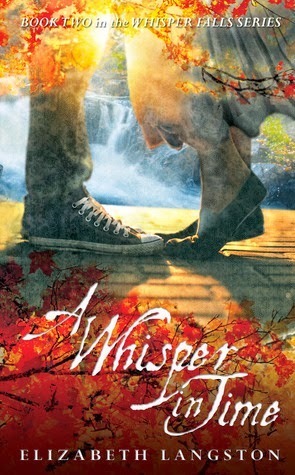
Elizabeth Langston's A Whisper in Time is available now, having been published April 6 by Spencer Hill Press. It features the same stock image, but it's been dressed up a bit. Rather than the girl not having anything covering her legs, there's been a skirt added. Rather than just the sun in the background, there's been a water scene added. Rather than sticking with the side images in the original, there's been some fall foliage to give the cover an even warmer feel. While I don't love how it looks -- I think it looks far too tinkered with -- I do like the feel of it, especially compared to the Alexander cover treatment.
Here's the description from WorldCat: Rescued from a life of servitude by the boy she loves, Susanna Marsh escapes across two centuries, only to be plunged into a world she's ill-prepared to face. Unable to work or go to school, Susanna finds herself dependent on others to survive. Immersed in the fun and demands of his senior year of high school, Mark Lewis longs to share his world with the girl who's captured his heart. But first he must tackle government bureaucracy to prove Susanna's identity.Overwhelmed by her new home, Susanna seeks refuge in history and in news of the people she left behind. But when she learns that danger stalks her sister, Susanna must weigh whether to risk her own future in order to save Phoebe's happiness.
What makes this cover work for this title is that it does feel historical. The girl having a skirt, rather than a bare leg, gives that suggestion, as does the color treatment. It doesn't feel entirely modern.
It's interesting to me that when there are so many potential cover options, that four books in the same year could use the same stock image. One got changed, but the other three remain the same (as of now, at least). It's not a bad image, and all of the designs have worked to make them distinct enough. But it makes me wonder why they can't be distinct without having to use the same picture. I'd like to see far more cover diversity on my shelves in terms of design. While text and image driven covers have really taken off in the last couple of years -- we can definitely thank The Fault in Our Stars and Eleanor & Park for that -- even when that keeps emerging again and again, it gets boring and waters down what covers can look like.
When you think of covers that stand out and are memorable, they're not ones that look like every other cover. They're ones that do something different -- think Winger for example or this year, Rebel Belle.
This matters because it does impact who these books reach on the most basic level. Covers are the book's biggest marketing tool. It sells the story to the reader. It is what compels a reader to look at the flap copy and see if it's something that interests them. If we rely on the same looks over and over, we can only ever reach the same exact readers over and over. A lot of this has to do with fear, of course. If a cover is different, will it sell? Will Barnes and Noble stock it? The publishing world is exceptionally conservative when it comes to risk taking.
Which leads me to ask a few things: what are some of your favorite and most memorable YA covers in the last couple of years and why? What made those covers stand out? What haven't you seen on covers that you would like to see?






 Related StoriesHardcover to Paperback: YA Redesigns to ConsiderHardcover to Paperback: Six YA Redesigns to ConsiderEye-Focused Covers in 2014
Related StoriesHardcover to Paperback: YA Redesigns to ConsiderHardcover to Paperback: Six YA Redesigns to ConsiderEye-Focused Covers in 2014

Sourcebooks unveiled this as the cover for Juliana Stone's Boys Like You at the end of last year or beginning of this year. It's cute, but it's not necessarily remarkable. It looks like a light romance title. But that cover didn't last long, and instead, Sourcebooks took it in a new direction:

This cover tells an entirely different story. It might still be a romance, but it doesn't look as light as the previous cover. The redesign definitely fits into the trend of text and image driven covers that are becoming the new dominant look in YA (almost to the point those all look the same too).
The book's description (via WorldCat): When Monroe Blackwell, who is spending the summer at her grandmother's Louisiana bed-and-breakfast, meets Nathan Everets, who has a court-appointed job there, they share, and begin to recover from, their respective feelings of loss and guilt.
I don't think either cover quite nails it via description alone. The tag line, which changed a little bit between cover redesigns, does a pretty good job capturing it, but I'm not sure where the guitar fits in in the new look and for the old one, it might just look too lighthearted.
Stone's book comes out May 6.
Let's return to that first cover iteration, though. That stock image is going to get quite a bit of play elsewhere, even though it didn't end up being used for Boys Like You.

Kat Spears's debut novel Sway will get the stock image. The title and the author placement are exactly the same as they were in Stone's book, too. Again, there's the feeling of a lighthearted romance here, despite the fact the tagline conveys something different.
Because Sway doesn't come out until September 16, there's not yet a description up in WorldCat, but here's the lengthier one from Goodreads:
High school senior Jesse Alderman, or Sway as he's known, could sell hell to a bishop. He also specializes in getting things people want—term papers, a date with the prom queen, fake IDs. It's all business with Jesse. He has few close friends and he never lets emotions get in the way.
But when Ken, captain of the football team, leading candidate for homecoming king, and all around jerk, hires Jesse to help him win the heart of the angelic Bridget Smalley, Jesse finds himself feeling all sorts of things. While following Bridget and learning the intimate details of her life, he falls helplessly in love for the very first time. He also finds himself in an accidental friendship with Bridget's younger brother who's belligerent and self-pitying after spending a lifetime dealing with cerebral palsy. Suddenly Jesse is visiting old folks at a nursing home in order to run into Bridget, and offering his time to help the less fortunate, all the while developing a bond with this young man who idolizes him. The tinman really does have a heart after all.
A Cyrano De Bergerac story with a modern twist, Sway is told from Jesse’s point of view with unapologetic truth and biting humor. His observations about the world around him are untempered by empathy or compassion--until Bridget's presence in his life forces him to confront his quiet devastation over a life changing event a year earlier and maybe, just maybe, feel SOMEthing, again.
It's a male point of view, though from the cover, I'd never quite get that. I like that my expectations are bucked like that, but I wonder how much the cover image conveys what the story looks to be about. It's a fairly generic image that suggests light romance, and I'm not sure if that's what the book is about.
While I do not think that books have gender and wouldn't hesitate to hand a boy a book like this, I think it's the kind of cover that could be difficult for boys to pick up on their own from the shelf. Romance fans, though, would definitely gravitate toward this, regardless of gender.
When Spears's cover was revealed a couple of weeks ago, another cover was revealed from Entangled Teen that looked pretty familiar.

The same stock image is the base for Shannon Alexander's Love and Other Unknown Variables, which will come out October 7. While it isn't the same exact treatment, it's clearly the same stock picture. What's interesting about this cover is that the side elements are completely different, as they've been done up with flowers (to the point where it looks like the plants are rubbing against the girl's leg in a weird and uncomfortable way) and the color has been completely stripped, save for the pops of red. The placement of the title and the author are completely different than in the Spears cover, which almost makes it not look like the same image.
Here's the description from Goodreads:
Charlie Hanson has a clear vision of his future. A senior at Brighton School of Mathematics and Science, he knows he'll graduate, go to MIT, and inevitably discover the solutions to the universe's greatest unanswerable problems. He'sthat smart.
The future has never seemed very kind to Charlotte Finch, so she's counting on the present. She would rather sketch with charcoal pencils, sing in her pitch-perfect voice, or read her favorite book than fill out a college application.
Charlie's future blurs the moment he meets Charlotte. She's not impressed by the strange boy until she learns he's a student at Brighton where her sister has just taken a job. At Charlotte's request, Charlie orchestrates the biggest prank campaign in Brighton history. But by the time Charlie learns Charlotte is ill and that the pranks were a way to distract her sister from Charlotte's illness, Charlotte's gravitational pull on him is too great to overcome. Soon he must choose between the familiar formulas he's always relied on or the girl he's falling for (at far more than 32 feet per second).
I can't get a clear read, but it seems to me that this book is told from more than one point of view, both Charlie's and Charlotte's. Like with Spears's cover, though, I think this has more appeal to female readers from the shelf perspective, particularly those who like romance.
I'm not sure I love the way this cover looks, changed from the original stock image. I feel more pulled toward Spears's, and perhaps it's because of the color and the way that the title and author's name are less obscuring of the image.
But wait! There's another cover out featuring this image.

Elizabeth Langston's A Whisper in Time is available now, having been published April 6 by Spencer Hill Press. It features the same stock image, but it's been dressed up a bit. Rather than the girl not having anything covering her legs, there's been a skirt added. Rather than just the sun in the background, there's been a water scene added. Rather than sticking with the side images in the original, there's been some fall foliage to give the cover an even warmer feel. While I don't love how it looks -- I think it looks far too tinkered with -- I do like the feel of it, especially compared to the Alexander cover treatment.
Here's the description from WorldCat: Rescued from a life of servitude by the boy she loves, Susanna Marsh escapes across two centuries, only to be plunged into a world she's ill-prepared to face. Unable to work or go to school, Susanna finds herself dependent on others to survive. Immersed in the fun and demands of his senior year of high school, Mark Lewis longs to share his world with the girl who's captured his heart. But first he must tackle government bureaucracy to prove Susanna's identity.Overwhelmed by her new home, Susanna seeks refuge in history and in news of the people she left behind. But when she learns that danger stalks her sister, Susanna must weigh whether to risk her own future in order to save Phoebe's happiness.
What makes this cover work for this title is that it does feel historical. The girl having a skirt, rather than a bare leg, gives that suggestion, as does the color treatment. It doesn't feel entirely modern.
It's interesting to me that when there are so many potential cover options, that four books in the same year could use the same stock image. One got changed, but the other three remain the same (as of now, at least). It's not a bad image, and all of the designs have worked to make them distinct enough. But it makes me wonder why they can't be distinct without having to use the same picture. I'd like to see far more cover diversity on my shelves in terms of design. While text and image driven covers have really taken off in the last couple of years -- we can definitely thank The Fault in Our Stars and Eleanor & Park for that -- even when that keeps emerging again and again, it gets boring and waters down what covers can look like.
When you think of covers that stand out and are memorable, they're not ones that look like every other cover. They're ones that do something different -- think Winger for example or this year, Rebel Belle.
This matters because it does impact who these books reach on the most basic level. Covers are the book's biggest marketing tool. It sells the story to the reader. It is what compels a reader to look at the flap copy and see if it's something that interests them. If we rely on the same looks over and over, we can only ever reach the same exact readers over and over. A lot of this has to do with fear, of course. If a cover is different, will it sell? Will Barnes and Noble stock it? The publishing world is exceptionally conservative when it comes to risk taking.
Which leads me to ask a few things: what are some of your favorite and most memorable YA covers in the last couple of years and why? What made those covers stand out? What haven't you seen on covers that you would like to see?







 Related StoriesHardcover to Paperback: YA Redesigns to ConsiderHardcover to Paperback: Six YA Redesigns to ConsiderEye-Focused Covers in 2014
Related StoriesHardcover to Paperback: YA Redesigns to ConsiderHardcover to Paperback: Six YA Redesigns to ConsiderEye-Focused Covers in 2014
Published on April 15, 2014 22:00
April 14, 2014
In the Shadows by Kiersten White and Jim Di Bartolo
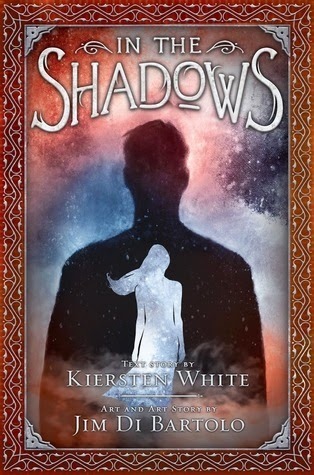 I’m a sucker for beautiful books, and
In the Shadows
is nothing if not beautiful. The cover tells you that the text story is by Kiersten White and the art story by Jim Di Bartolo, letting you know right away that the art is not just a series of pretty illustrations – they tell a story that intertwines with the text in important ways, if inscrutable at first.
I’m a sucker for beautiful books, and
In the Shadows
is nothing if not beautiful. The cover tells you that the text story is by Kiersten White and the art story by Jim Di Bartolo, letting you know right away that the art is not just a series of pretty illustrations – they tell a story that intertwines with the text in important ways, if inscrutable at first. The story is set (mostly) in Maine, in 1900, in a boardinghouse run by a widowed woman, Mrs. Johnson. She has two teenage daughters, Cora and Minnie. Arthur, a rather brooding teenager, has been sent to stay at the boardinghouse for mysterious reasons; ditto for teen brothers Charles and Thomas. Charles, the elder brother, is dying from an unspecified disease. Together, the five teens become caught up in a dark conspiracy that goes back many years. I won’t share much more (that would ruin some of the fun of discovery), but I will say that the conspiracy is supernatural in origin.
Reading this book was a bit like playing the computer game Myst. Those of you who have played it, or any of its sequels, will know that there’s a storyline, often featuring strange secrets and faraway places, that the player must discover along the way. There are the stunning graphics that tell part of the story, but then there’s also journals, letters, and voiceover – text, really – that tells the rest. Figuring out how everything goes together is the main puzzle of Myst, and I felt like this book was a similar sort of puzzle. The book alternates between art chapters and text chapters. The art chapters have no captions and no dialogue. There are a few letters to characters, but they’re partly obscured so you can’t make out them entirely. They’re clues. The fun, the discovery, is learning how the art story and text story coalesce. It’s not readily apparent at first; stick with it. The rewards are worth it.
I loved Jim Di Bartolo’s work on Lips Touch: Three Times, so it’s unsurprising that I loved it here as well. Here, his art is equal in significance to the text, inviting multiple re-reads and long moments spent poring over the panels. His work is very moody, fitting the tone of the story. His colors are bold, and he uses a liberal amount of black, often casting his characters in shadow. I encourage you to check out a few samples at his website. His art is entirely my style.
White’s no slouch here either. She chooses to tell her part of the story by varying the points of view, though everything remains third person. I think she does a fine job of developing the characters in this way. She doesn’t get a whole lot of space to do it, considering the book is 384 pages and many of those pages belong to the art. At first I had a hard time remembering who was whom (which one is the sick one? Which ones are related?), but this didn’t last long. She gets across quite nicely Charles’ cheerfulness as well as his desperation, Thom’s feelings of helplessness, Cora’s fear, Minnie’s desire to help Cora past that fear – often in unwise ways. The only other book of hers I’ve read is Mind Games, and I think the writing of In the Shadows is much stronger.
Even these text pages are works of art – everything is on glossy paper with lovely, subdued splashes of color around the borders. The whole book has the weight of a graphic novel. In many ways, the stories told by the text and art are not completely original, but the way they’re told is, and that’s what makes this book stand out.
This is a book that needs to be read twice. The first time, read it straight through as presented; the second, go back and re-read just the art. You’ll pick up on more details, and most of your lingering questions will be answered. In the Shadows is unique among current YA offerings (though I’m not wild about its generic title) and will satisfy fantasy readers looking for something different.
Review copy provided by the publisher at TLA. In the Shadows will be published April 29.







 Related StoriesOn Expectations for Girls in YA Fiction, Misleading Reviews, and SexualityNew This Spring: Two Snappy ReviewsSalvage by Alexandra Duncan
Related StoriesOn Expectations for Girls in YA Fiction, Misleading Reviews, and SexualityNew This Spring: Two Snappy ReviewsSalvage by Alexandra Duncan
Published on April 14, 2014 22:00
April 13, 2014
On Expectations for Girls in YA Fiction, Misleading Reviews, and Sexuality
 A few weeks ago, I picked up and devoured Julie Halpern's The F-It List. It's a story about two girls who are best friends and how their relationship weathers everything. It starts with Becca sleeping with Alex's boyfriend the day of Alex's father's funeral. The summer immediately following, the girls aren't hanging out as much as they used to. Sure, Alex is angry and upset about what Becca did, but their reason for not hanging out has much more to do with Alex's need to grieve losing her father than it does what Becca did or losing that boyfriend.
A few weeks ago, I picked up and devoured Julie Halpern's The F-It List. It's a story about two girls who are best friends and how their relationship weathers everything. It starts with Becca sleeping with Alex's boyfriend the day of Alex's father's funeral. The summer immediately following, the girls aren't hanging out as much as they used to. Sure, Alex is angry and upset about what Becca did, but their reason for not hanging out has much more to do with Alex's need to grieve losing her father than it does what Becca did or losing that boyfriend.When the school year begins, Alex learns via another girl that something awful happened to Becca over the summer: she was diagnosed with cancer. Alex immediately runs to Becca's side, and their friendship, while not perfectly patched up, is allowed to continue, and it's through this agreement of continuing their relationship that Becca asks Alex for a favor. She needs to complete her f-word-rhymes-with-bucket list. Since Becca's sick and worried a bit about what her future may hold, she wants Alex to do and experience a number of things that she's always wanted to do but wonders if she'll ever have the chance to do.
A number of items on the list have to do with sex. Becca wants Alex to masturbate, and she wants Alex to have sex with someone she can say I love you to and mean it. Other items on the list range from doing some silly prank-like stuff to more relationship-driven items. But it is those sexually-related items that Alex homes in on most and those are the items that come to signify not just a lot of what the relationship between the two girls is -- blunt, honest, and unashamed -- but also points where readers may either bristle or dig in for something deeper. In many ways, I thought the ways that both the sexually-related items and the friendship more broadly played out in the story were what made The F-It List knock out. It's rare to see such positive portrayals of sex for girls. Both Becca and Alex enjoyed sex and both were very open and honest about liking it and sharing those positive experiences with one another.
But not everyone felt this to be the case. Here's the review Halpern's novel got in School Library Journal (you can click to make it larger):

I've read and reread this review many times, and every time, something new feels off in it. Keep in mind many trade reviewers review from advanced reader copies of books, meaning that not all of the kinks have been entirely worked out.
I note, too, that I also read The F-It List from an advanced reader copy.
Although I could dive into the notion that Alex performs the items on the f-it list out of guilt -- an idea I disagree with entirely, as Alex begins to really embrace this as a commitment to her relationship with Becca -- what I find fascinating is this line: "Both girls have casual, unprotected sex with all of their boyfriends without any thoughts of taking precautions."
This line presumes a few things in it. The first is that it's the responsibility of the girls to think about and carry out the actions necessary for protection during sex. While print space is limited and words have to be carefully selected in a trade review, the way this particular line is phrased, in conjunction with the line before it, casts a judgment upon the female characters in the story. They're crass, with limited vocabulary, and they're not taking responsibility for their own actions. These are the kinds of girls you don't want to be role models for readers, since they're not being "good girls." They don't arouse sympathy because what happens to them is all a matter of consequences and choices they make. They weren't smart enough or thinking through things enough to protect themselves.
But what is worse in this line is that it's factually incorrect.
Early in the book, Alex talks about the first time she's had sex, as a means of thinking through Becca's request that she have sex with someone she loves and cares about. The first person -- and only person at that point -- she'd slept with was a boy named Aleks, who was a foreign exchange student. Starting at page 76 in the advanced reader copy, Alex lays out the story as follows:
Becca was disappointed I hadn't seen his penis yet and handed me a condom the next time I saw her. Two days later, armed with the Trojan, I followed Aleks back to his house again. [...] Me in my underwear, him in blue boxers, we moved over to the bed. "Wait--" I told him, the first work spoken that afternoon. I found Becca's condom in my backpack and brought it up to the bed. [...] He slapped on the condom.
It's pretty evident immediately that condoms play a role in not just Alex's sex life, but in the discussions she and Becca have had as best friends about being sexually active. Alex got the condom from Becca, and Alex insisted that Aleks wear it when they slept together. Seems straightforward enough.
But there's more.
Later on in the story, when Alex begins a relationship with Leo, the issue of the condom isn't the only one that comes up before they take the plunge and have sex (they had a few intimate moments, but in each case, Leo stopped when Alex asked him to). She talks about why she wants to make sure there is protection. Starting on page 141 of the advanced reader copy:
His hands were gentler than I wanted, and I grabbed one and wrapped it around my breast. I let out a sigh, and Leo reciprocated with a sound of his own. "So you have a condom?" I asked. Life had been too cruel in the last year not to get me pregnant or diseased if I wasn't careful. I couldn't trust my body to do the right thing, and I didn't want to have a conversation with Leo in the middle of this to talk past sexual partners. I didn't want to know. I just needed it to happen.
Immediately after, Leo puts on a condom.
In both instances, Alex takes precaution. In both instances, it is Alex -- the girl -- who insists on using a condom before engaging in intercourse and in the second section, Alex lays out why it is she finds taking this precaution important. With everything going on in her life right now, she recognizes that not being careful would only lead to further problems. She didn't want to saddler herself with that, nor did she want to get into it with Leo, either. It's clear and evident that Alex thought about precautions prior to intercourse, and she's not shy in laying that out there for readers, just as she's not shy in laying out there what and how she comes to enjoy her budding sexuality.
I'm struck by that review line again because it seems to me the reviewer missed these things (reading too quickly? Not paying close enough attention to the details yet still bringing them up in the review?). But I'm further struck in thinking about whether or not we as readers need to be hit over the head with how careful our protagonists -- females especially -- need to express how they're protecting themselves when they choose to engage in sex.
Did the reviewer find fault in the fact that Alex doesn't tell us about condom use in subsequent sexual situations, despite the fact she's made it clear she wouldn't be crazy enough to have sex without a condom? Is it necessary for every instance of sex, whether on the page or fade to black, be explicit in its depiction of protection use? And if that's the case, where is there a line drawn between telling the story and being faithful to how the characters are and positing an over-the-head message about safe sex? Do readers believe that if Alex doesn't explain in every sexual moment that she's making sure there's a condom in place that she's chosen instead to not protect herself? Because as a reader, I assume when it's laid out there for me as openly as it is, that there will be a condom. That I don't need to be reminded again and again.
Because when real people have sex and are resolute in their wanting to be protected against pregnancy and disease, it becomes a routine, rather than a point of conscious decision making. You always have that box of condoms or you're faithful in taking birth control (or both or neither). The story isn't in the routine; it's in the break from the routine. In Alex's case, the routine is protecting herself, and I think any more insertion of the condom lines through the story would have turned this from a book where Alex (and Becca) really come to embrace their ability to be sexual beings to a story where they become pawns for the Message of "make sure you use protection."
Part of me wonders, too, whether the fact this is such a positive portrayal of girls embracing sex and doing so without apology and without holding back on being crude and, at times, obscene, is what will hold some readers back from seeing these smaller moments when Alex is very keen on keeping herself and Leo safe. Halpern hasn't written an easy story here in any capacity. But I think it's this complexity which makes The F-It List such a great, memorable read. Because it's not about Becca's diagnosis. It's not about death or the fear of that. It's about embracing life and relationships -- friendly and romantic -- to their fullest in whatever way you need to. It's unfortunate, though, that a trade review in one of the largest, most well-respected library journals could be factually incorrect about the story. In doing so, this book might not end up in the hands of those readers -- girls particularly -- who would get so much out of it. Who would see themselves in Alex or in Becca. Who would see it's perfectly okay to enjoy sex alone or with a partner.
And that yes, it's important to take precautions for yourself and have solid reasons behind why.
I can't help wonder, too, whether books that do similar things as Halpern's but feature a male main character undergo the same scrutiny and character judgment.







 Related StoriesNew This Spring: Two Snappy ReviewsSalvage by Alexandra DuncanPointe by Brandy Colbert
Related StoriesNew This Spring: Two Snappy ReviewsSalvage by Alexandra DuncanPointe by Brandy Colbert
Published on April 13, 2014 22:00
April 10, 2014
An Interview with Laurie Halse Anderson at Book Riot

I'm so excited about a post I had at Book Riot earlier this week that I wanted to direct readers over there for the day. I got the opportunity to interview Laurie Halse Anderson. We talked about the 15th anniversary of Speak, the way that the YA world has changed over the last 15 years, how she feels about challenges to her work, and we dug into gender and the book world. Check it out.
It's neat to get the chance to interview someone that you've "known" since you were a teenager. I read Speak when I was in high school, and it's a title that has stayed with me since. As you may or may not know, Laurie and her publisher are working on the #Speak4RAINN15 campaign to raise money to help survivors of sexual violence this month. Details are on the Riot post. When I posted the piece, I made a donation (which will be matched) and I encourage anyone who can make a donation to do so, too. If you can't, the next best thing you can do is spread the word, which also makes a difference.
I'm really proud of this interview, and I love the conversation Laurie and I were able to have. I hope you enjoy it, too!







 Related StoriesTwitterview: Brandy Colbert (POINTE)Twitterview: Karen Sandler (+ giveaway!)Taking Contemporary YA to Book Riot, too
Related StoriesTwitterview: Brandy Colbert (POINTE)Twitterview: Karen Sandler (+ giveaway!)Taking Contemporary YA to Book Riot, too
Published on April 10, 2014 22:00
April 9, 2014
Going Graphic: Graphic Novels on the Outstanding Books for the College Bound List
In continuing the short reviews and discussion of the titles on this year's Outstanding Books for the College Bound list (OBCB), I thought I'd hit on format in this roundup, rather than thematic connections. One of the things that makes me really proud of the work we did on this list was that we included a nice number of graphic novels and graphic non-fiction titles. Even though it seems like those who are huge readers have been "on to" graphic books forever, it's still a format not everyone widely accepts as a legitimate type of reading. The books that we were able to include in a list of books for those who want to attend college or who are life long learners in the graphic format definitely prove otherwise -- included here are both fiction and non-fiction graphic novels, as well as a couple of graphic novel hybrids.
These titles spanned all of the categories on the OBCB list, so I haven't read them all personally. Because of that, I'm going to format this roundup a little bit differently than the previous formats. I'll offer up the official WorldCat description for each, and then for the titles I have read or have more to elaborate upon, I'll note that beneath.
As a bonus, many of the graphic novels are also diverse titles.


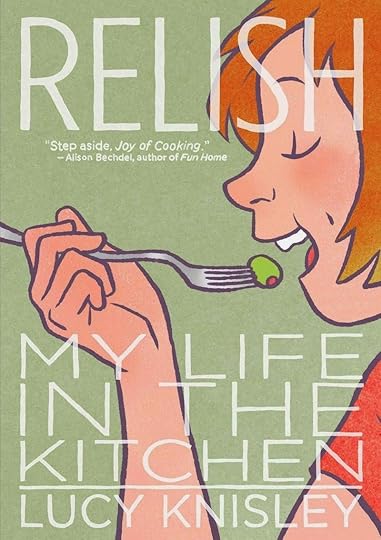
March: Book One by John Lewis, Andrew Aydin, and Nate Powell: John Lewis's autobiographical account of his lifelong battle for civil rights for all Americans.
I didn't get a chance to read this one, but it looks like an outstanding (auto)biographical work about John Lewis's life and how much a role he played during the civil rights movement.
Philosophy: A Discovery in Comics by Margreet De Heer: A fun introduction in comics to deep thinking and the history of philosophy.
The WorldCat description tells you everything and nothing about this little gem. It is a fun introduction to the history of philosophy, but it's more than that. While it definitely offers a solid history, the core of the book is about how readers can learn to develop their own ideas about philosophy and figure out what their own philosophy on life is. It's easy to follow and it's not going to go over the heads (nor bore!) readers who may not be interested in philosophy or those who think that philosophy is a tough, hard-to-grasp concept. This makes it really easy.
Relish: My Life in the Kitchen by Lucy Knisley: Lucy Knisley loves food. The daughter of a chef and a gourmet, this talented young cartoonist comes by her obsession honestly. In her forthright, thoughtful, and funny memoir, Lucy traces key episodes in her life thus far, framed by what she was eating at the time and lessons learned about food, cooking, and life. Each chapter is bookended with an illustrated recipe-- many of them treasured family dishes, and a fewof them Lucy's original inventions.
I reviewed this book last year, well before deciding to nominate it for OBCB consideration. What made this a standout and one we decided to put on the Arts & Humanities list was how much love was poured into food and eating. This is the kind of book anyone -- from a passionate foodie to a person who merely enjoys a good meal now and then to the reader who has never thought much about the food they eat -- could get into. Knisley's art is really enjoyable, and her ability to be respectful of the way food connects us as people and the way food becomes a centerpiece to our lives gets at the heart of arts and humanities.
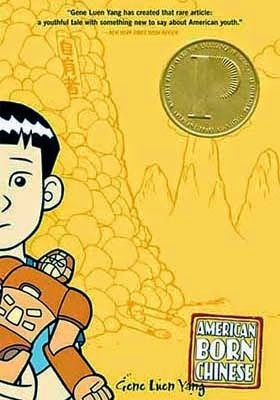

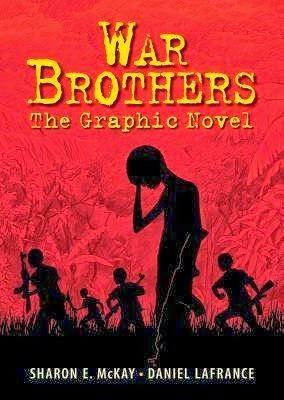
American Born Chinese by Gene Luen Yang: Alternates three interrelated stories about the problems of young Chinese Americans trying to participate in the popular culture. Presented in comic book format.
That's not the most useful WorldCat description, but it's pretty spot on about what the book is. It's been a long time since I read this one -- back in grad school is when I think I read it -- but it's one that's stuck with me not just because it's three interconnected stories about the Chinese-American experience, but also because of how outstanding the artwork is. This is easily a classic of YA literature and of graphic novels for young readers (if not graphic novels, period) and it's a perfect fit for the list.
Feynman by Jim Ottaviani and Leland Myrick: In this substantial graphic novel biography, First Second presents the larger-than-life exploits of Nobel-winning quantum physicist, adventurer, musician, world-class raconteur, and one of the greatest minds of the twentieth century: Richard Feynman. Written by nonfiction comics mainstay Jim Ottaviani and brilliantly illustrated by First Second author Leland Myrick, Feynman tells the story of the great man's life from his childhood in Long Island to his work on the Manhattan Project and the Challenger disaster. Ottaviani tackles the bad with the good, leaving the reader delighted by Feynman's exuberant life and staggered at the loss humanity suffered with his death.
War Brothers: The Graphic Novel by Sharon McKay and Daniel Lefrance: Jacob is a 14-year-old Ugandan who is sent away to a boys' school. Once there, he assures his friend Tony that they need not be afraid -- they will be safe. But not long after, in the shadow of the night, the boys are abducted. Marched into the jungle, they are brought to an encampment of the feared rebel soldiers. They are told they must kill or be killed, and their world turns into a terrifying struggle to endure and survive.
This is a title I didn't get my hands on, despite being on one of my own subcommittee's lists. If you'll remember, one of the things I talked about in terms of the committee process is that sometimes, you don't get to read everything (in this case, the book was too new and I couldn't get it at work, nor could I interlibrary loan it) but a good argument and discussion by those who did read it can persuade you to consider it worth including on the list. I've since acquired it for my library and look forward to checking it out.
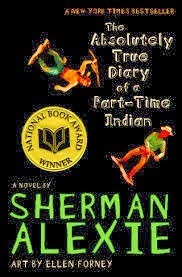
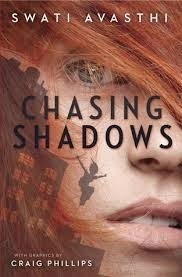
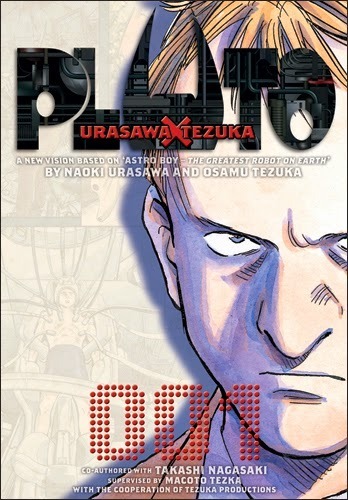
The Absolutely True Diary of a Part-Time Indian by Sherman Alexie: Budding cartoonist Junior leaves his troubled school on the Spokane Indian Reservation to attend an all-white farm town school where the only other Indian is the school mascot.
Alexie's novel isn't a straight graphic novel -- it's a hybrid. It's been years since I read this one, but like with Yang's title, it's a staple of YA lit and it's a perfect fit for the Literature and Languages list. This could have easily fit, too, on the History and Cultures list.
Chasing Shadows by Swati Avasthi and Craig Phillips: Chasing Shadows is a searing look at the impact of one random act of violence. Before: Corey, Holly, and Savitri are one unit-- fast, strong, inseparable. Together they turn Chicago concrete and asphalt into a freerunner's jungle gym, ricocheting off walls, scaling buildings, leaping from rooftop to rooftop. But acting like a superhero doesn't make you bulletproof. After: Holly and Savitri are coming unglued. Holly says she's chasing Corey's killer, chasing revenge. Savitri fears Holly's just running wild-- and leaving her behind. Friends should stand by each other in times of crisis. But can you hold on too tight? Too long? In this intense novel, told in two voices, and incorporating comic-style art sections, Swati Avasthi creates a gripping portrait of two girls teetering on the edge of grief and insanity. Two girls who will find out just how many ways there are to lose a friend-- and how many ways to be lost.
I reviewed Avasthi's title before I nominated it for our list and I still stand behind everything in that review for why it belongs on the OBCB list. One other reason is that this story is set in that strange time period between the end of high school and whatever comes next. Though there have been more of those books in recent years, Avasthi's handling of the social elements in that time frame -- friendship, specifically -- really makes it stand out. This, like Alexie's book, is a graphic hybrid, rather than a solid graphic novel.
Pluto by Naoki Urasawa (the entire manga series): In a world where man and robots coexist, the powerful Swiss robot Mont Blanc has been destroyed. Elsewhere a key figure in a robot rights group is murdered. The two incidents appear to be unrelated...except for one very conspicuous clue - the bodies of both victims have been fashioned into some sort of bizarre collage complete with makeshift horns placed by the victims' heads. Interpol assigns robot detective Gesicht to this most strange and complex case - and he eventually discovers that he too, as one of the seven great robots of the world, is one of the targets.
This series of books is on the Science and Technology list, and it's one that I didn't read. It sounds really fantastic though, and I appreciate how an entire manga series is on the OBCB list -- not only does it showcase how graphic novels can be "real reading," but it shows that even a format that many consider to be "lesser" than more "prestigious" graphic novels are worthwhile, thought-provoking, important reads.
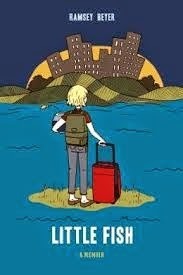
Little Fish: A Memoir From a Different Kind of Year by Ramsey Beyer: Told through real-life journals, collages, lists, and drawings, this coming-of-age story illustrates the transformation of an 18-year-old girl from a small-town teenager into an independent city-dwelling college student. Written in an autobiographical style with beautiful artwork, Little Fish shows the challenges of being a young person facing the world on her own for the very first time and the unease--as well as excitement--that comes along with that challenge.
Beyer's memoir is maybe less of a graphic novel than the others on this list, but I'm including it because the style will have appeal to those readers who love the graphic format. This is sort of collage/scrapbook style storytelling, with art, lists, and images sprinkled throughout the story of Beyer's first year at art school. What's great about this book and why it fits so well on the list is that it's the first-hand experience of the first year of being away at school. There are highs and there are lows, there are expectations met and failed, and there is a lot of musing about relationships past and present. It's honest and heartfelt, and it's the kind of realistic portrayal I wish I'd read before I went to college. It would have definitely made me feel less alone or weird in some of the less-than-pleasant feelings I had when I went to college and away from home.
For the previous roundups of titles on the Outstanding Books for the College Bound list, you can find them on the topics of music and musicality, religion and spirituality, girls across borders, and football and football culture.






 Related StoriesGirls Across Borders: Reviews from the Outstanding Books for the College Bound ListNew This Spring: Two Snappy ReviewsSalvage by Alexandra Duncan
Related StoriesGirls Across Borders: Reviews from the Outstanding Books for the College Bound ListNew This Spring: Two Snappy ReviewsSalvage by Alexandra Duncan
These titles spanned all of the categories on the OBCB list, so I haven't read them all personally. Because of that, I'm going to format this roundup a little bit differently than the previous formats. I'll offer up the official WorldCat description for each, and then for the titles I have read or have more to elaborate upon, I'll note that beneath.
As a bonus, many of the graphic novels are also diverse titles.



March: Book One by John Lewis, Andrew Aydin, and Nate Powell: John Lewis's autobiographical account of his lifelong battle for civil rights for all Americans.
I didn't get a chance to read this one, but it looks like an outstanding (auto)biographical work about John Lewis's life and how much a role he played during the civil rights movement.
Philosophy: A Discovery in Comics by Margreet De Heer: A fun introduction in comics to deep thinking and the history of philosophy.
The WorldCat description tells you everything and nothing about this little gem. It is a fun introduction to the history of philosophy, but it's more than that. While it definitely offers a solid history, the core of the book is about how readers can learn to develop their own ideas about philosophy and figure out what their own philosophy on life is. It's easy to follow and it's not going to go over the heads (nor bore!) readers who may not be interested in philosophy or those who think that philosophy is a tough, hard-to-grasp concept. This makes it really easy.
Relish: My Life in the Kitchen by Lucy Knisley: Lucy Knisley loves food. The daughter of a chef and a gourmet, this talented young cartoonist comes by her obsession honestly. In her forthright, thoughtful, and funny memoir, Lucy traces key episodes in her life thus far, framed by what she was eating at the time and lessons learned about food, cooking, and life. Each chapter is bookended with an illustrated recipe-- many of them treasured family dishes, and a fewof them Lucy's original inventions.
I reviewed this book last year, well before deciding to nominate it for OBCB consideration. What made this a standout and one we decided to put on the Arts & Humanities list was how much love was poured into food and eating. This is the kind of book anyone -- from a passionate foodie to a person who merely enjoys a good meal now and then to the reader who has never thought much about the food they eat -- could get into. Knisley's art is really enjoyable, and her ability to be respectful of the way food connects us as people and the way food becomes a centerpiece to our lives gets at the heart of arts and humanities.



American Born Chinese by Gene Luen Yang: Alternates three interrelated stories about the problems of young Chinese Americans trying to participate in the popular culture. Presented in comic book format.
That's not the most useful WorldCat description, but it's pretty spot on about what the book is. It's been a long time since I read this one -- back in grad school is when I think I read it -- but it's one that's stuck with me not just because it's three interconnected stories about the Chinese-American experience, but also because of how outstanding the artwork is. This is easily a classic of YA literature and of graphic novels for young readers (if not graphic novels, period) and it's a perfect fit for the list.
Feynman by Jim Ottaviani and Leland Myrick: In this substantial graphic novel biography, First Second presents the larger-than-life exploits of Nobel-winning quantum physicist, adventurer, musician, world-class raconteur, and one of the greatest minds of the twentieth century: Richard Feynman. Written by nonfiction comics mainstay Jim Ottaviani and brilliantly illustrated by First Second author Leland Myrick, Feynman tells the story of the great man's life from his childhood in Long Island to his work on the Manhattan Project and the Challenger disaster. Ottaviani tackles the bad with the good, leaving the reader delighted by Feynman's exuberant life and staggered at the loss humanity suffered with his death.
War Brothers: The Graphic Novel by Sharon McKay and Daniel Lefrance: Jacob is a 14-year-old Ugandan who is sent away to a boys' school. Once there, he assures his friend Tony that they need not be afraid -- they will be safe. But not long after, in the shadow of the night, the boys are abducted. Marched into the jungle, they are brought to an encampment of the feared rebel soldiers. They are told they must kill or be killed, and their world turns into a terrifying struggle to endure and survive.
This is a title I didn't get my hands on, despite being on one of my own subcommittee's lists. If you'll remember, one of the things I talked about in terms of the committee process is that sometimes, you don't get to read everything (in this case, the book was too new and I couldn't get it at work, nor could I interlibrary loan it) but a good argument and discussion by those who did read it can persuade you to consider it worth including on the list. I've since acquired it for my library and look forward to checking it out.



The Absolutely True Diary of a Part-Time Indian by Sherman Alexie: Budding cartoonist Junior leaves his troubled school on the Spokane Indian Reservation to attend an all-white farm town school where the only other Indian is the school mascot.
Alexie's novel isn't a straight graphic novel -- it's a hybrid. It's been years since I read this one, but like with Yang's title, it's a staple of YA lit and it's a perfect fit for the Literature and Languages list. This could have easily fit, too, on the History and Cultures list.
Chasing Shadows by Swati Avasthi and Craig Phillips: Chasing Shadows is a searing look at the impact of one random act of violence. Before: Corey, Holly, and Savitri are one unit-- fast, strong, inseparable. Together they turn Chicago concrete and asphalt into a freerunner's jungle gym, ricocheting off walls, scaling buildings, leaping from rooftop to rooftop. But acting like a superhero doesn't make you bulletproof. After: Holly and Savitri are coming unglued. Holly says she's chasing Corey's killer, chasing revenge. Savitri fears Holly's just running wild-- and leaving her behind. Friends should stand by each other in times of crisis. But can you hold on too tight? Too long? In this intense novel, told in two voices, and incorporating comic-style art sections, Swati Avasthi creates a gripping portrait of two girls teetering on the edge of grief and insanity. Two girls who will find out just how many ways there are to lose a friend-- and how many ways to be lost.
I reviewed Avasthi's title before I nominated it for our list and I still stand behind everything in that review for why it belongs on the OBCB list. One other reason is that this story is set in that strange time period between the end of high school and whatever comes next. Though there have been more of those books in recent years, Avasthi's handling of the social elements in that time frame -- friendship, specifically -- really makes it stand out. This, like Alexie's book, is a graphic hybrid, rather than a solid graphic novel.
Pluto by Naoki Urasawa (the entire manga series): In a world where man and robots coexist, the powerful Swiss robot Mont Blanc has been destroyed. Elsewhere a key figure in a robot rights group is murdered. The two incidents appear to be unrelated...except for one very conspicuous clue - the bodies of both victims have been fashioned into some sort of bizarre collage complete with makeshift horns placed by the victims' heads. Interpol assigns robot detective Gesicht to this most strange and complex case - and he eventually discovers that he too, as one of the seven great robots of the world, is one of the targets.
This series of books is on the Science and Technology list, and it's one that I didn't read. It sounds really fantastic though, and I appreciate how an entire manga series is on the OBCB list -- not only does it showcase how graphic novels can be "real reading," but it shows that even a format that many consider to be "lesser" than more "prestigious" graphic novels are worthwhile, thought-provoking, important reads.

Little Fish: A Memoir From a Different Kind of Year by Ramsey Beyer: Told through real-life journals, collages, lists, and drawings, this coming-of-age story illustrates the transformation of an 18-year-old girl from a small-town teenager into an independent city-dwelling college student. Written in an autobiographical style with beautiful artwork, Little Fish shows the challenges of being a young person facing the world on her own for the very first time and the unease--as well as excitement--that comes along with that challenge.
Beyer's memoir is maybe less of a graphic novel than the others on this list, but I'm including it because the style will have appeal to those readers who love the graphic format. This is sort of collage/scrapbook style storytelling, with art, lists, and images sprinkled throughout the story of Beyer's first year at art school. What's great about this book and why it fits so well on the list is that it's the first-hand experience of the first year of being away at school. There are highs and there are lows, there are expectations met and failed, and there is a lot of musing about relationships past and present. It's honest and heartfelt, and it's the kind of realistic portrayal I wish I'd read before I went to college. It would have definitely made me feel less alone or weird in some of the less-than-pleasant feelings I had when I went to college and away from home.
For the previous roundups of titles on the Outstanding Books for the College Bound list, you can find them on the topics of music and musicality, religion and spirituality, girls across borders, and football and football culture.







 Related StoriesGirls Across Borders: Reviews from the Outstanding Books for the College Bound ListNew This Spring: Two Snappy ReviewsSalvage by Alexandra Duncan
Related StoriesGirls Across Borders: Reviews from the Outstanding Books for the College Bound ListNew This Spring: Two Snappy ReviewsSalvage by Alexandra Duncan
Published on April 09, 2014 22:00
April 8, 2014
New This Spring: Two Snappy Reviews
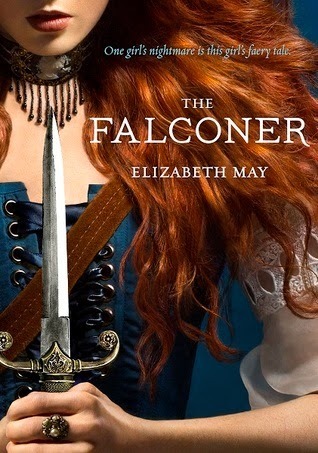

The Falconer by Elizabeth May
May brings us savage, murderous faeries in her debut featuring a teenage girl with the unique ability to hunt them down. A faery killed Aileana's mother and since then, she's vowed to exact revenge upon it - as well as any other faeries she can get her hands on, with the exception of a sympathetic faery who trains her and a tiny pixie who keeps her company and mends her clothing. The story, set in 1844, is notable for its exploration of faery lore, which is (according to an author note) based on actual Scottish mythology. May's faeries are sometimes beautiful, sometimes hideous, but always deadly, hearkening back to a time when all supernatural beings were referred to as faeries by the Scots.
There's some romantic tension between Aileana and her trainer, the faery Kiaran, who sometimes seems human and at other times is definitely, absolutely not. It kind of works, if you can get past the fact that he's thousands of years old and she is a teenager. The writing is mostly good, though not uniformly so. May is able to communicate quite clearly how devastated Aileana is by her mother's death. In many ways, this is a very dark book, full of violence and despair. I wish the plot had been a bit more complex - it mostly involves Aileana hunting faeries, then strategizing with Kiaran once they learn that a whole horde of the most dangerous kinds of faeries are about to be released upon the world. The pseudo-twist ending may be the most interesting part of the book - too bad we couldn't get there sooner. Nevertheless, this should please fans of fairies and books heavy on action.
Sekret by Lindsay Smith
I was intrigued by the premise of this debut, which is set in Soviet Russia in 1963 and involves teenage psychics recruited (read: blackmailed) by the KGB into serving as spies. Protagonist Yulia is one of these spies. The KGB is threatening her family and coercing her into sabotaging the American space program.
Much of the book focuses on Yulia's training as she struggles to discover who among the other recruits she can trust (none of them). She learns how to put up mental walls to fend off psychic attacks as well as how best to attack others, gleaning the information her captors require. Above all, she wants to escape and rescue her family.
What this book does well is portray Yulia's internal struggles - her mind under attack from others, her desperation over her situation, her struggle to hone her skills. I wished the plot were a bit more exciting, though. For a story about spies, it's pretty slow and the missions they're sent on aren't terribly exciting. I have trouble remembering much of them at all. As with The Falconer, there's some interesting stuff right at the end, but up to that point, there's just not a lot going on. But psychics and spies are both trendy now, so I expect a book featuring them working for the KGB will go over well.
Review copies provided by the publishers. The Falconer will be available May 6. Sekret is available now.







 Related StoriesSalvage by Alexandra DuncanPointe by Brandy ColbertRevisiting YA Verse Novels: A 2014 Guide to the Format
Related StoriesSalvage by Alexandra DuncanPointe by Brandy ColbertRevisiting YA Verse Novels: A 2014 Guide to the Format
Published on April 08, 2014 22:00
April 7, 2014
Salvage by Alexandra Duncan
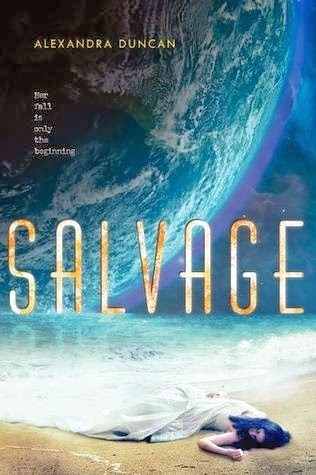 I've written before about how I'm tired of young adult science fiction that is only capable of imagining a future where women are treated in awful ways (usually explicit or de facto sexual slavery). Often, these sorts of hypothetical societies seem done more for shock value than to serve the story and its characters, and they frequently do not take a hard look at where certain Earth societies are now and postulate a logical future for them. So you can imagine my trepidation going into
Salvage
by Alexandra Duncan.
I've written before about how I'm tired of young adult science fiction that is only capable of imagining a future where women are treated in awful ways (usually explicit or de facto sexual slavery). Often, these sorts of hypothetical societies seem done more for shock value than to serve the story and its characters, and they frequently do not take a hard look at where certain Earth societies are now and postulate a logical future for them. So you can imagine my trepidation going into
Salvage
by Alexandra Duncan.The story begins on a space ship where grown men take multiple teenage girls as wives. Women and girls are not allowed to set foot on Earth (though men are), and the culture's mythology prevents them from doing something as basic as singing, much less making repairs to the ship or anything else besides child-rearing.
Ava was born into this society, aboard a trading ship called the Parastrata. She is sixteen and has been told she is to become a wife to a man aboard the Aether. When it appears that Luck, the captain's son and her friend and sweetheart of sorts, is to be that man, she is overjoyed. But Ava and Luck make a terrible mistake based on faulty information, and Ava finds herself on the run from her family and the crews of both the Parastrata and the Aether.
What I've mentioned above is actually a fairly small portion of the book. Most of Ava's story takes place on Earth. She initially escapes to the Gyre, a continent-sized trash heap in the middle of the Pacific Ocean. She's taken in by a scarred (physically and metaphorically) but kind woman and her pre-teen daughter, who teach Ava how to fly a ship. Afterward, Ava finds herself in Mumbai, seeking her mother's sister. These two settings are wildly different (one completely fabricated), but equally well-realized.
This is a slower-paced book, not as chock-full of action as, say, Beth Revis' Across the Universe or Amy Kathleen Ryan's Glow, which it's been compared to (though it still reads very quickly). Duncan takes time to immerse the reader in each place she creates, whether that place is space, the Pacific Ocean, or India. Everything is told through Ava's eyes, so the wonder and mystery and strangeness of all these settings is made very clear. That's one thing I really loved about this book: it highlights just how overwhelming it is to find yourself in a place where no one understands you. And the place where Ava is understood, at least to a degree - the Parastrata - does make sense in the context of the story. Duncan's writing never makes what happens aboard the ship seem salacious. The fact that the ships are so isolated from Earth, free of any regulation but their own, in a harsh environment, does make it more likely that they'd develop a society that adheres to a very rigid set of rules that benefits those already in power. This is addressed in more depth near the end of the book.
It's clear that future Earth is wildly different from present-day Earth, but we don't get an infodump that explains how it got that way. Instead, we discover on our own. Duncan lets the reader infer from what Ava sees: the trash in the middle of the ocean, the difference in living conditions between different classes of people in Mumbai, and so on. When done right, world-building is a discovery, and I feel like Duncan nailed it.
There's a lot that Duncan packs into her novel, theme-wise: the meaning of family, the ethics of objectively studying another human culture, class privilege, gender and sexuality. Furthermore, the cast is multi-racial and multi-cultural, so important and so rare in mainstream YA SF. And if that weren't enough to entice you to pick this one up, Ava is also good at math and mechanical repairs - in fact, she taught herself how to do sums! I'll be the first to say I dislike math, but it is so very nice to read about a girl who loves it and excels at it.
Readers who aren't big fans of science fiction may initially shy away from Ava's narration, as her speech patterns are a bit odd. She uses some words in different ways than we do; it takes some getting used to. I really appreciate when an author does this. Again, there's no explanation for the oddness in speech - we figure out what it means along the way. It's just another way Duncan brings us into Ava's world.
YA books set in space are trendy right now. This one is more thoughtful and less plot-driven than the others, more like a classic coming-of-age story, different but no worse than thrillers like Glow or Across the Universe. Salvage is a good book for more patient teens who will appreciate reading about a sheltered girl who comes into her own as a young woman in a wild, sometimes-scary, often-beautiful world.
Review copy provided by my librarian book twin and Angie (@misskubelik). Salvage is available now.







 Related StoriesPointe by Brandy ColbertGirls Across Borders: Reviews from the Outstanding Books for the College Bound ListEnders by Lissa Price
Related StoriesPointe by Brandy ColbertGirls Across Borders: Reviews from the Outstanding Books for the College Bound ListEnders by Lissa Price
Published on April 07, 2014 22:00
April 6, 2014
Revisiting YA Verse Novels: A 2014 Guide to the Format
April is poetry month, and while we didn't write a lengthy genre guide to verse novels that month to celebrate, we did write one in May. If you're curious about the format of YA novels in verse, that should get you set on what it is, why it's so appealing, and it offers a pretty extensive reading list to titles published in the last few years.
Since I didn't want to replicate work and write another guide to the genre, I thought it would be worthwhile to talk about the books in 2014 that are verse novels. Some of the titles are out already, while others will be publishing before the end of the year. This list is for titles published by traditional publishers, and it's very possible that I'll overlook some, so feel free to jump in with additional titles in the comments. A couple of titles below could easily be middle grade, as they fall into that strange category of being good for readers from age 10 to 14. I'm including them anyway.
All descriptions are from WorldCat, and I've included publication dates for titles not yet available. Of course, if you're a fanatic of verse novels, make sure you check out Verse Novels and that you stay tuned for the third annual verse novels series over at Clear Eyes, Full Shelves, which will take place the last week of April.
Of note: a nice percentage of these titles are diverse.
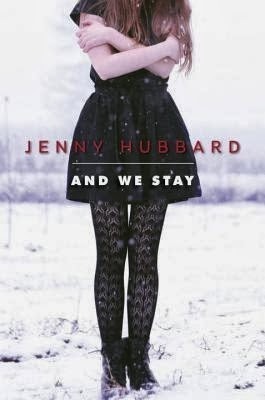
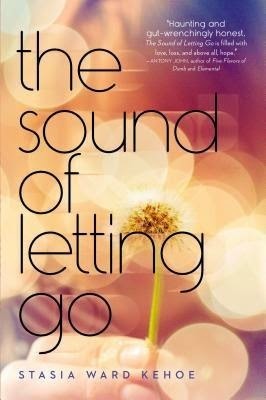
And We Stay by Jenny Hubbard: Sent to an Amherst, Massachusetts, boarding school after her ex-boyfriend shoots himself, seventeen-year-old Emily expresses herself through poetry as she relives their relationship, copes with her guilt, and begins to heal. **This book is partially in verse and partially in traditional prose.
The Sound of Letting Go by Stasia Ward Kehoe: At seventeen, Daisy feels imprisoned by her brother Steven's autism and its effects and her only escape is through her trumpet into the world of jazz, but when her parents decide to send Steven to an institution she is not ready to let him go.
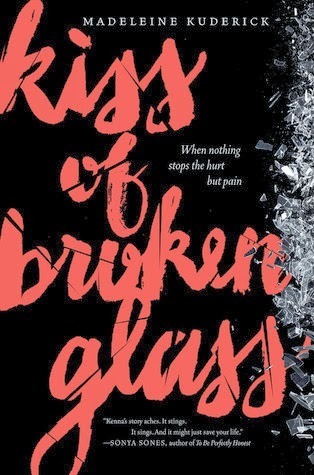
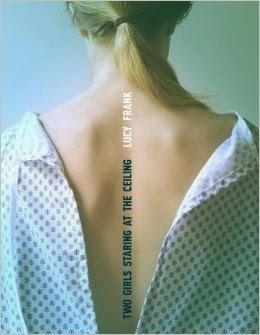
Kiss of Broken Glass by Madeline Kuderick (September 9): After she’s caught in the school bathroom cutting herself with the blade from a pencil sharpener, fifteen-year-old Kenna is put under mandatory psychiatric watch. She has seventy-two hours to face her addiction, deal with rejection, and find a shred of hope. Description via Goodreads.
Two Girls Staring At The Ceiling by Lucy Frank (August 5): Chess, the narrator, is sick, but with what exactly, she isn’t sure. And to make matters worse, she must share a hospital room with Shannon, her polar opposite. Where Chess is polite, Shannon is rude. Where Chess tolerates pain silently, Shannon screams bloody murder. Where Chess seems to be getting slowly better, Shannon seems to be getting worse. How these teenagers become friends, helping each other come to terms with their illness, makes for a dramatic and deeply moving read. Description via Goodreads.
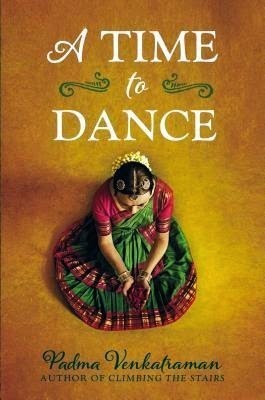
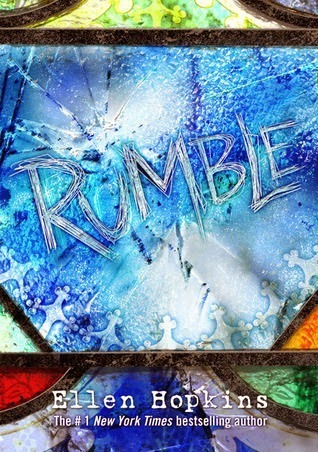
A Time To Dance by Padma Venkatraman (May 1): In India, a girl who excels at Bharatanatyam dance refuses to give up after losing a leg in an accident.
Rumble by Ellen Hopkins (August 26): Eighteen-year-old Matt's atheism is tested when, after a horrific accident of his own making that plunges him into a dark, quiet place, he hears a voice that calls everything he has ever disbelieved into question.
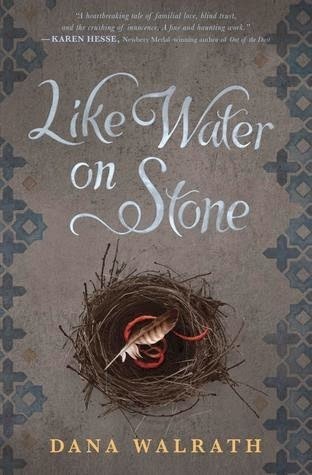
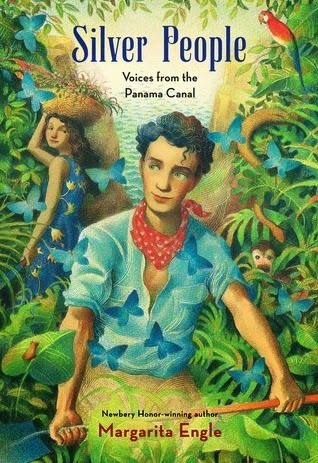
Like Water on Stone by Dana Walrath (November 11): Inspired by a true story, this relates the tale of siblings Sosi, Shahen, and Mariam who survive the Armenian genocide of 1915 by escaping from Turkey alone over the mountains.
Silver People: Voices From the Panama Canal by Margarita Engle: Fourteen-year-old Mateo and other Caribbean islanders face discrimination, segregation, and harsh working conditions when American recruiters lure them to the Panamanian rain forest in 1906 to build the great canal.
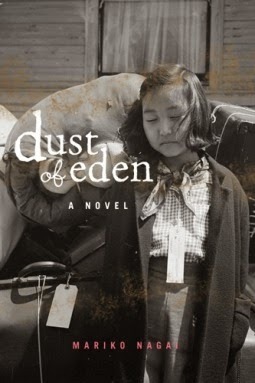

Dust of Eden by Mariko Nagai: Thirteen-year-old Mina Tagawa and her Japanese-American family are forced to evacuate their Seattle home and are relocated to an internment camp in Idaho, where they live for three years.
Caminar by Skila Brown: Carlos knows that when the soldiers arrive with warnings about the Communist rebels, it is time to be a man and defend the village, keep everyone safe. But Mama tells him not yet -- he's still her quiet moonfaced boy. The soldiers laugh at the villagers, and before they move on, a neighbor is found dangling from a tree, a sign on his neck: Communist. Mama tells Carlos to run and hide, then try to find her ... Numb and alone, he must join a band of guerillas as they trek to the top of the mountain where Carlos's abuela lives. Will he be in time, and brave enough, to warn them about the soldiers? What will he do then? A novel in verse inspired by actual events during Guatemala's civil war, Caminar is the moving story of a boy who loses nearly everything before discovering who he really is.
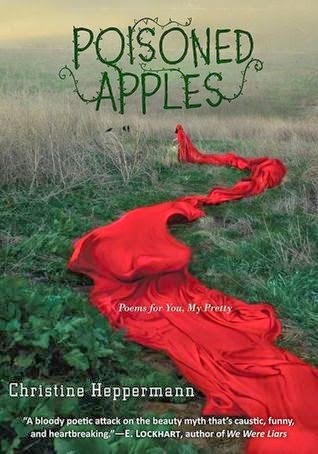
Poisoned Apples by Christina Heppermann (September 23): Christine Heppermann's powerful collection of free verse poems explore how girls are taught to think about themselves, their bodies, their friends--as consumers, as objects, as competitors. Based on classic fairy tale characters and fairy tale tropes, the poems range from contemporary retellings to first person accounts set within the original stories. From Snow White cottage and Rapunzel's tower to health class and the prom, these poems are a moving depiction of young women, society, and our expectations. Poisoned Apples is a dark, clever, witty, beautiful, and important book for teenage girls, their sisters, their mothers, and their best friends. **While not a traditional novel in verse, I'm including this title since verse lovers will definitely be interested.







 Related StoriesTwitterview: Brandy Colbert (POINTE)Pointe by Brandy ColbertGet Genrefied: Realistic Teens on the Big Screen
Related StoriesTwitterview: Brandy Colbert (POINTE)Pointe by Brandy ColbertGet Genrefied: Realistic Teens on the Big Screen
Since I didn't want to replicate work and write another guide to the genre, I thought it would be worthwhile to talk about the books in 2014 that are verse novels. Some of the titles are out already, while others will be publishing before the end of the year. This list is for titles published by traditional publishers, and it's very possible that I'll overlook some, so feel free to jump in with additional titles in the comments. A couple of titles below could easily be middle grade, as they fall into that strange category of being good for readers from age 10 to 14. I'm including them anyway.
All descriptions are from WorldCat, and I've included publication dates for titles not yet available. Of course, if you're a fanatic of verse novels, make sure you check out Verse Novels and that you stay tuned for the third annual verse novels series over at Clear Eyes, Full Shelves, which will take place the last week of April.
Of note: a nice percentage of these titles are diverse.


And We Stay by Jenny Hubbard: Sent to an Amherst, Massachusetts, boarding school after her ex-boyfriend shoots himself, seventeen-year-old Emily expresses herself through poetry as she relives their relationship, copes with her guilt, and begins to heal. **This book is partially in verse and partially in traditional prose.
The Sound of Letting Go by Stasia Ward Kehoe: At seventeen, Daisy feels imprisoned by her brother Steven's autism and its effects and her only escape is through her trumpet into the world of jazz, but when her parents decide to send Steven to an institution she is not ready to let him go.


Kiss of Broken Glass by Madeline Kuderick (September 9): After she’s caught in the school bathroom cutting herself with the blade from a pencil sharpener, fifteen-year-old Kenna is put under mandatory psychiatric watch. She has seventy-two hours to face her addiction, deal with rejection, and find a shred of hope. Description via Goodreads.
Two Girls Staring At The Ceiling by Lucy Frank (August 5): Chess, the narrator, is sick, but with what exactly, she isn’t sure. And to make matters worse, she must share a hospital room with Shannon, her polar opposite. Where Chess is polite, Shannon is rude. Where Chess tolerates pain silently, Shannon screams bloody murder. Where Chess seems to be getting slowly better, Shannon seems to be getting worse. How these teenagers become friends, helping each other come to terms with their illness, makes for a dramatic and deeply moving read. Description via Goodreads.


A Time To Dance by Padma Venkatraman (May 1): In India, a girl who excels at Bharatanatyam dance refuses to give up after losing a leg in an accident.
Rumble by Ellen Hopkins (August 26): Eighteen-year-old Matt's atheism is tested when, after a horrific accident of his own making that plunges him into a dark, quiet place, he hears a voice that calls everything he has ever disbelieved into question.


Like Water on Stone by Dana Walrath (November 11): Inspired by a true story, this relates the tale of siblings Sosi, Shahen, and Mariam who survive the Armenian genocide of 1915 by escaping from Turkey alone over the mountains.
Silver People: Voices From the Panama Canal by Margarita Engle: Fourteen-year-old Mateo and other Caribbean islanders face discrimination, segregation, and harsh working conditions when American recruiters lure them to the Panamanian rain forest in 1906 to build the great canal.


Dust of Eden by Mariko Nagai: Thirteen-year-old Mina Tagawa and her Japanese-American family are forced to evacuate their Seattle home and are relocated to an internment camp in Idaho, where they live for three years.
Caminar by Skila Brown: Carlos knows that when the soldiers arrive with warnings about the Communist rebels, it is time to be a man and defend the village, keep everyone safe. But Mama tells him not yet -- he's still her quiet moonfaced boy. The soldiers laugh at the villagers, and before they move on, a neighbor is found dangling from a tree, a sign on his neck: Communist. Mama tells Carlos to run and hide, then try to find her ... Numb and alone, he must join a band of guerillas as they trek to the top of the mountain where Carlos's abuela lives. Will he be in time, and brave enough, to warn them about the soldiers? What will he do then? A novel in verse inspired by actual events during Guatemala's civil war, Caminar is the moving story of a boy who loses nearly everything before discovering who he really is.

Poisoned Apples by Christina Heppermann (September 23): Christine Heppermann's powerful collection of free verse poems explore how girls are taught to think about themselves, their bodies, their friends--as consumers, as objects, as competitors. Based on classic fairy tale characters and fairy tale tropes, the poems range from contemporary retellings to first person accounts set within the original stories. From Snow White cottage and Rapunzel's tower to health class and the prom, these poems are a moving depiction of young women, society, and our expectations. Poisoned Apples is a dark, clever, witty, beautiful, and important book for teenage girls, their sisters, their mothers, and their best friends. **While not a traditional novel in verse, I'm including this title since verse lovers will definitely be interested.







 Related StoriesTwitterview: Brandy Colbert (POINTE)Pointe by Brandy ColbertGet Genrefied: Realistic Teens on the Big Screen
Related StoriesTwitterview: Brandy Colbert (POINTE)Pointe by Brandy ColbertGet Genrefied: Realistic Teens on the Big Screen
Published on April 06, 2014 22:00
April 4, 2014
Links of Note: April 5, 2014
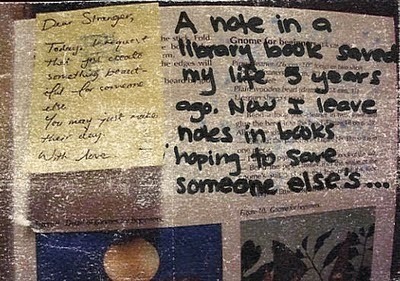 from postsecret
from postsecretSince I put together a link roundup last weekend, this roundup is a bit shorter than usual. With that, let's dive right in:
While not book related, this piece about teenagers is well-worth reading and considering, especially for those of us who work with them. Teen girls engage in vicious cyberbullying, and this is according to a jury of their own peers. Rita Meade rounded up a series of tweets by librarian Gretchen Caserotti who sat in on a local school board's discussion about pulling Sherman Alexie's Diary of a Part-Time Indian off their supplemental high school reading list. She also included some context for the challenge and the disappointing results for the book. Here's what censorship looks like. Daniel Ehrenhaft wrote a really interesting piece for the CBC Diversity blog about trying to sell foreign rights of US novels abroad at the Bologna Book Fair. More specifically, he talks about how realistic fiction featuring diverse characters aren't easy sells overseas and he digs into that a bit. This week, Laurie Halse Anderson did an AMA over at Reddit that is well worth reading. After she did, she sent me a message on Tumblr alerting me she'd linked to a post I wrote and she was curious what I thought about her answer about the "John Greenification" of YA. So I responded. Perhaps it's teasing to say this conversation between us will be continued in the (very) near future. That leads me into alerting readers that it's the 15th anniversary of Speak this year, and there's a mega campaign to raise money for RAINN as a part of the celebration. Details, including how Macmillan is matching donations, can be found here. And continuing this string of links, I wrote about books that make great next reads for fans of Anderson's Speak at Book Riot this week. These are all titles that tackle sexual assault/sexual violence/rape in some capacity. Ellen Oh wrote about not being the "model minority." At Latin@s in Kid Lit, Zoraida Cordova talks about what it means when we talk about diversity in YA. I thought this piece about Rick Bayless's massive Mexican culinary research library was super interesting and a lot of fun to see. Here's a big roundup of bookish offerings on Netflix. In response to Chloe Grace Moretz's comment that there wasn't a lot of YA out there that was as good as If I Stay (where she plays the lead), Courtney Summers wrote this incredible book list of YA that she should know about. Here's a place to find all kinds of titles you might not be readily aware of but you should read and talk about.







 Related StoriesQuick Saturday Links: March 29, 2014Links of Note: March 22, 2014Links of Note: March 8, 2014
Related StoriesQuick Saturday Links: March 29, 2014Links of Note: March 22, 2014Links of Note: March 8, 2014
Published on April 04, 2014 22:00
April 3, 2014
A Pair of Cybils Reviews
Since I can't discuss Cybils finalists before the winner is announced, I like to revisit the titles a little while later and give some brief thoughts. Today I'm discussing a couple of titles that I didn't personally love, but will no doubt speak to others.
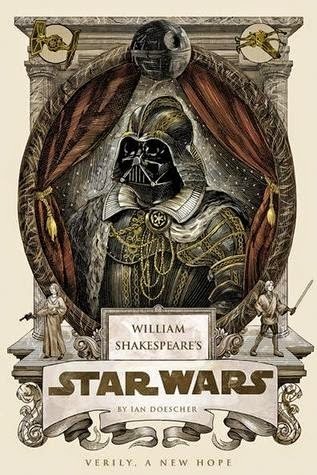
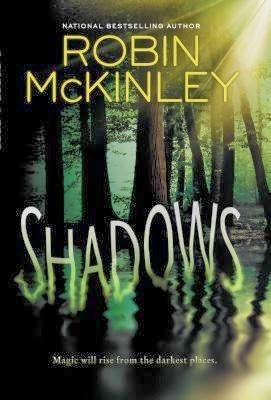
William Shakespeare's Star Wars: Verily, a New Hope by Ian Doescher
This book is a fun little literary exercise by Doescher - the first Star Wars movie re-imagined as Shakespeare would have told it. Doescher really committed, writing it all in full iambic pentameter, five acts, the whole shebang. (Even R2D2's speech is written in iambic pentameter.) He also slips in a lot of in-jokes for Shakespeare fans - references to Hamlet, that sort of thing.
This would be a treat for mega fans of Star Wars and Shakespeare, though that audience is probably quite narrow, as those readers would also have to want to see two of their favorite things mashed together (and not everyone likes that). Still, this is a fun novelty item. It's interesting to see how Doescher makes it all work.
Shadows by Robin McKinley
I really wanted to love this one, but it was not to be. McKinley's latest is a combination of fantasy and science fiction, set in a world where magic has been outlawed and strange shadows cling to Maggie's new stepfather. Maggie knows that something is off about Val, and not just because of his shadows.
Most of my dislike of this book stems from the writing style. Maggie narrates her own story, and her narration is circuitous and tangent-prone and not very organized. It's not quite stream of consciousness, but nearly. I'm not opposed to this technique in general, but Maggie's constant asides just aren't particularly interesting, and by the time she returns us to her original point, we've forgotten what it was in the first place. They also don't do much to help the reader understand her world, which is one of many. She lives in Newworld, and Val is from Oldworld. Plus, there's Midworld and Southworld and Farworld. I'm all for world-building that develops via discovery instead of infodumps, but we've got to understand what the heck is going on before half the book is up. I didn't. I was confused and bored for much of it.






 Related StoriesA Cybils RetrospectiveA Quick Break - Cybils Finalists
Related StoriesA Cybils RetrospectiveA Quick Break - Cybils Finalists


William Shakespeare's Star Wars: Verily, a New Hope by Ian Doescher
This book is a fun little literary exercise by Doescher - the first Star Wars movie re-imagined as Shakespeare would have told it. Doescher really committed, writing it all in full iambic pentameter, five acts, the whole shebang. (Even R2D2's speech is written in iambic pentameter.) He also slips in a lot of in-jokes for Shakespeare fans - references to Hamlet, that sort of thing.
This would be a treat for mega fans of Star Wars and Shakespeare, though that audience is probably quite narrow, as those readers would also have to want to see two of their favorite things mashed together (and not everyone likes that). Still, this is a fun novelty item. It's interesting to see how Doescher makes it all work.
Shadows by Robin McKinley
I really wanted to love this one, but it was not to be. McKinley's latest is a combination of fantasy and science fiction, set in a world where magic has been outlawed and strange shadows cling to Maggie's new stepfather. Maggie knows that something is off about Val, and not just because of his shadows.
Most of my dislike of this book stems from the writing style. Maggie narrates her own story, and her narration is circuitous and tangent-prone and not very organized. It's not quite stream of consciousness, but nearly. I'm not opposed to this technique in general, but Maggie's constant asides just aren't particularly interesting, and by the time she returns us to her original point, we've forgotten what it was in the first place. They also don't do much to help the reader understand her world, which is one of many. She lives in Newworld, and Val is from Oldworld. Plus, there's Midworld and Southworld and Farworld. I'm all for world-building that develops via discovery instead of infodumps, but we've got to understand what the heck is going on before half the book is up. I didn't. I was confused and bored for much of it.







 Related StoriesA Cybils RetrospectiveA Quick Break - Cybils Finalists
Related StoriesA Cybils RetrospectiveA Quick Break - Cybils Finalists
Published on April 03, 2014 22:00



